![]()
![]()
![]()
Use LEFT and RIGHT arrow keys to navigate between flashcards;
Use UP and DOWN arrow keys to flip the card;
H to show hint;
A reads text to speech;
62 Cards in this Set
- Front
- Back
|
Order: Odonata
Family? Common name: Narrpw-winged damselflies |
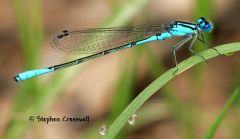
usually with black pattern
their ground color may be green, blue, yellow, orange, or purple their wings are narrow, usually colorless and clear wings stalked two antenodal cross veins vein M3 arising nearer to nodus than arculus |
|
|
Order: Odonata
Family:? Common name: Broad winged damselflies |
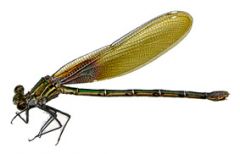
cal-lop-ter-RIDGE-geh-dee
Calopterygidae is a family of damselflies in the order Odonata and are commonly known as broad-winged damselflies or demoiselles. These rather large damselflies have wingspans of 5–8 cm and they're often metallic-coloured. The family contains some 150 species. As the common name suggests they have broader wings than other damselflies and at rest hold their wings parallel to the body and slightly elevated |
|
|
Order: Odonata
Family? Common name: Common skimmers |
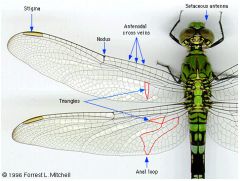
Libellulidae
Pronunciation: lie-bell-LU-li-dee The three dragonfly families in the superfamily Libelluloidea are all characterized by: matched antenodal crossveins triangles of the front and hind wing being of dissimilar shape. Species in the family Libellulidae are separated from those in Macromiidae and Corduliidae by having a boot-shaped anal loop in the hind wing. |
|
|
Order: Orthoptera
Family: ? Common name" Katydids, long horn grasshoppers |

Tettigoniidae
Pronunciation: teh-tih-go-NIGH-id-dee Identifying characteristics for the family Tettigoniidae include: Antennae long and threadlike (cf Acrididae). Tarsi 4-segmented. Tympanum at base of front tibia, if present. Ovipositor long and swordshaped |
|
|
Order: Orthoptera
Family:? Common name: short horned grasshoppers |
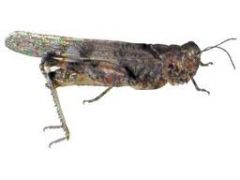
Acrididae
pronotum does not extend beyond base of wings wings usually well-developed, but short (brachypterous) or absent (apterous) in some species, and wing length may be variable within a single species antennae short, typically about one-half body length, with less than 30 segments tympana (hearing organs), if present, are on the sides of the first abdominal segment hind femora greatly enlarged (for jumping), typically about as long as hind wings ovipositor short and stout all tarsi have three segments (tarsal formula 3-3-3) |
|
|
Order: Orthoptera
Family: ?? Common name: Crickets |
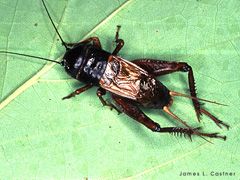
Gryllidae
Identifying characteristics for the family Gryllidae include: * Ovipositor long and slender. * Antennae long. * Tympanum at base of front tibia, if present. * Tarsi 3-segmented |
|
|
Order: Blattodea
Family: ? Common name: Cockroaches |
blattidae
|
|
|
Order: Mantodea
Family:? Common name: Praying mantids |
Mantidae
|
|
|
Order: Blattodea
Family: ? Common name: Termites |
Rhinotermitidae
|
|
|
Order: Hemiptera
Family: ? Common name: Aphids |
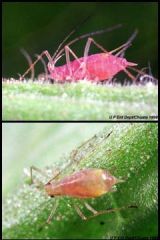
Aphididae
dentifying characteristics for the family Aphididae include: * Soft-bodied, pear-shaped insects with delicate-looking legs and 6-segmented antennae. * Most species have a pair of cornicles projecting from the posterior of the abdomen. * Front wings with 4 to 6 veins below the darkened stigma, the media being branched. |
|
|
Order: Hemiptera
Family: ?? Common name: Planthoppers |

Flatidae
|
|
|
Order: Hemiptera
Family: ? Common name: leaf hoppers |
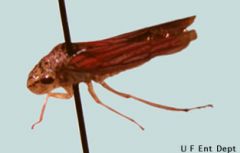
Cicadellidae sik-ah-DELL-ih-dee
Characteristics for distinguishing the Cicadellidae include: * Smaller, more active than Cicadidae. * Do not have the extended pronotum of the Membracidae. * Hind tibiae with 1 or more rows of spines; such rows lacking in the Cercopidae. * In dorsal view, the Cicadellidae tend to be more elongate, less oval, than the Cercopidae |
|
|
Order: Hemiptera
Family: ? Common name: Froghoppers |

Cercopidae cer-COPE-pi-dee
# Smaller, more active than Cicadidae. # Do not have the extended pronotum of the Membracidae. # Have 1 or 2 stout spines on the hind tibiae and a circlet of spines at the apex; do not have one or more rows of spines as do the Cicadellidae |
|
|
Order: Hemiptera
Family: ?? Common name: Cicadas |
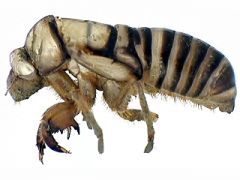
Cicadidae
|
|
|
Order: Hemiptera
Family? Common name: Bed bugs |

Family: Cimicidae
Identification: body flat, broadly oval, yellowish to reddish-brown; very short non-functional wings |
|
|
Order: Hemiptera
Family: ? Common name: leaf footed bugs |
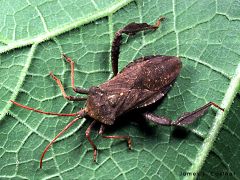
Family: Coreidae
Head narrower than and often shorter than the pronotum. Hind tibiae of some species expanded and resembling leaves |
|
|
Order: Hemiptera
Family: ?? Common name: water striders |
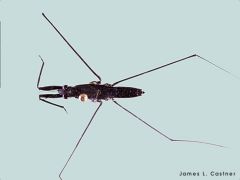
Family: Gerridae
More common of the two families that run around on the water. Front legs short, middle and hind legs long and slender. Middle legs arising closer to the hind legs than to the front legs. The common species have an elongate abdomen; some species with the abdomen very short |
|
|
Order: Hemiptera
Family: ?? Common name: seed bugs |

Family: Lygaeidae
lie-GEE-i-dee Antennae, 4-segmented; ocelli, 2; beak, 4-segmented; front wing with 4 or 5 veins; tarsi, 3-segmented. Antennae arise below line drawn through eyes. Second to Miridae in number of species |
|
|
Order: Hemiptera
Family: ?? Common name: stink bugs |
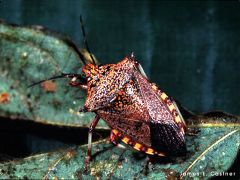
Family: Pentatomidae
pen-ta-TOM-mi-dee Body somewhat shield-shaped in dorsal view. Triangular scutellum about as long as the corium of the front wings. |
|
|
Order: Hemiptera
Family: ??? common name: Assassin bugs |
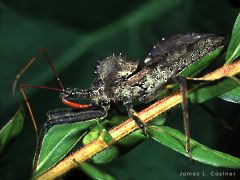
Family: reduviidae
reh-deu-VIE-i-dee Short, stout, 3-segmented beak. Head elongate with transverse groove behind eyes. The Reduviidae vary greatly in body size and shape, ranging from small and either slender or robust to fairly long and slender like some walkingsticks. The characteristic that distinguishes them from all other hemipterans is the stout 3-segmented beak that fits into a grove on the prosternum. |
|
|
Order: Neuroptera
Family: ?? Common name: green lacewings |
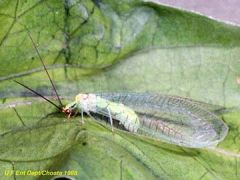
Family: Chrysopidae
cry-SOAP-pih-dee Soft, green-bodied insects with copper-colored eyes, long filiform antennae, and lacy wings Larvae have long sickle-like mandibles and are voracious predators |
|
|
Order: Coleoptera
Family: ?? common name: Metallic wood boring beetles |
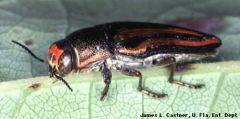
Family: Buprestidae
boo-PRESS-te-dee First abdominal sternite entire, not divided by hind coxae (suborder Polyphaga). Hard bodied, elongate-slender to elongate-robust beetles, ranging from 2 to 40 mm in length. Many species metallic or bronzed in appearance, especially on the ventral surface. Antennae usually short and sawtoothed. Tarsi 5-5-5. |
|
|
Order: Coleoptera
Family: ?? Common name: Soldier beetles |
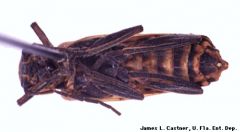
Family: Cantharidae
can-THAIR-ri-dee First abdominal sternite entire, not divided by hind coxae (suborder Polyphaga). Adults parallel sided, elongate, and soft-bodied, 1-15 mm long. Head protruding from flattened pronotum, generally visible from above (cf Lampyridae). Antennae generally filiform, rarely serrate or pectinate. Lack the light-producing organs of the similar looking Lampyridae. Common species found on flowers are brown and yellow. Tarsi 5-5-5, 4th segment lobed. |
|
|
Order: Coleoptera
family: ?? Common name: Groud beetles |
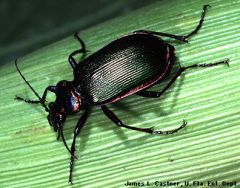
Family: Carabidae
ca-RAB-bi-dee First abdominal sternite divided by hind coxae (suborder Adephaga) Head at eyes nearly always narrower than pronotum (cf Cicindelidae). Antennae threadlike, inserted between mandibles and eyes (cf Cicindelidae). Generally black and shiny with striate elytra, but sometimes metallic or colorful. |
|
|
Order: Coleoptera
Family: ?? Common name: Longicorn beetles |

Family: Cerambycidae
cer-am-BIS-si-dee Long filiform antennae, ranging from one-half to over two times the length of the body. Body usually elongate and cylindrical; 2- to 60-mm in length. Eyes generally notched with antenna arising within the notch. Tarsi apparently 4-4-4, really 5-5-5 with the 4th segment small and inconspicuous |
|
|
Order: Coleoptera
Family: ?? Common name: leaf beetles |

Family: Chrysomelidae
cry-so-MEL-li-dee Elongate-subcylindrical to oval shaped beetles, 1- to 16-mm in length. Antennae generally less than 1/2 the length of the body. Eyes generally not notched. Tarsi generally appear 4-4-4, actually 5-5-5. |
|
|
Order: Coleoptera
Family: ?? Common name: Ladybird beetles, lady bug |
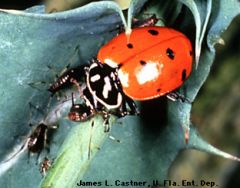
Family: Coccinellidae
cock-si-NEL-li-dee |
|
|
Order: Coleoptera
Family: ?? Common name: weevils |
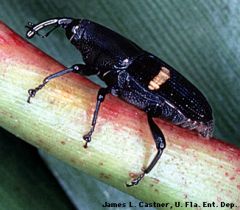
Family: Curculionidae
cur-cool-lee-ON-nih-dee Head usually with snout ranging from broad and flat in a few species to elongate and narrow in most species. Antennae usually elbowed and with 3-segmented club. Length from 0.6 to 35 mm, mostly less than 10 mm; body often covered with scales. Tarsi apparently 4-4-4, actually 5-5-5. |
|
|
Order: Coleoptera
Family: ?? Common name: lighteningbugs |

Family: Lampyridae
lamb-PIER-ri-dee |
|
|
Order: Coleoptera
Family: ?? Common name: net winged beetle |

Family: Lycidae
Lycid Beetles have a soft flattened body. They are usually brick red and black in colour,. The wing covers have prominent ridges along their length. The antennae are serrated and quite broad. Their bright colour is a warning to predators that they are not pleasant to eat. |
|
|
Order: Coleoptera
Family: ? Common name: Sap beetles |
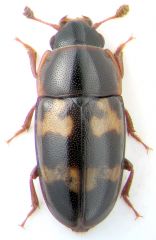
Family: Nitidulidae
|
|
|
Order: Coleoptera
Family:?? Common name: Scarab beetles |

Family: Scarabidae
|
|
|
Order: coleoptera
Family: ?? Common name: rove beetles |
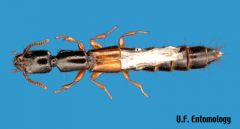
Family: Staphylinidae
First abdominal sternite entire, not divided by hind coxae (suborder Polyphaga). Adults elongate-slender, 0.7-25 mm. Elytra short, leaving 3 to 6 abdominal segments exposed. Tarsi usually 5-5-5, but 4-5-5, 5-4-4, et al. |
|
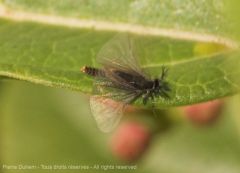
Order: Strepsiptera
Family: ?? Common name: Twisted winged parasite |
Family: Stylopidae
Strepsiptera are a little known order which is nevertheless often mentionned in the literature. As a matter of fact, those insects only have two wings but, against Diptera, they have hind wings and fore halters. |
|

Order: Diptera
Family: ?? Common name: robber flies |
Family: Asilidae
All robber flies have stout, spiny legs, a dense moustache of bristles on the face (mystax), and 3 simple eyes (ocelli) in a characteristic depression between their two large compound eyes. The mystax helps protect the head and face when the fly encounters prey bent on defense. The antennae are short, 3-segmented, sometimes with a bristle-like structure called an arista. The short, strong proboscis is used to stab and inject victims with saliva containing neurotoxic and proteolytic enzymes which paralyze and digest the insides; the fly then sucks the liquefied meal through the proboscis. Many species have long, tapering abdomens, sometimes with a sword-like ovipositor. Others are fat-bodied bumblebee mimics. Adult robber flies attack other flies, beetles, butterflies and moths, various bees, ants, dragon and damselflies, Ichneumon wasps, grasshoppers, and some spiders. |
|
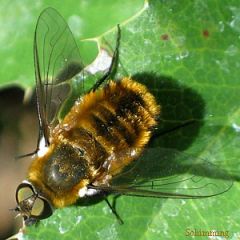
Order: Diptera
Family: ?? Common name: Bee flies |
Family: bombyliidae
|
|
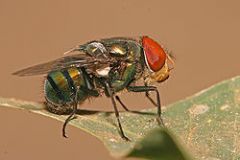
Order: Diptera
Family: ?? Common name: Blow flies |
Family: Calliphoridae
Calliphoridae adults are commonly shiny with metallic coloring, often with blue, green, or black thoraxes and abdomen |
|
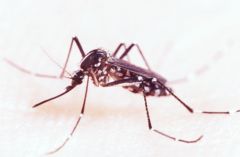
Order: Diptera
Family: ?? common name: Mosquitoes |
Family: Culicidae
|
|
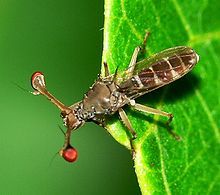
Order: diptera
Family: ?? common name: Stalk-eyed flies |
Family: Diopsidae
Stalk-eyed flies are insects of the fly family Diopsidae. The family is distinguished by the possession of eyestalks: projections from the sides of the head with the eyes at the end. Some fly species from other dipteran families such as the Drosophilidae and Tephritidae carry similar structures but the unique character of the Diopsidae is that the antennae are carried next to the eye at the end of the stalk |
|
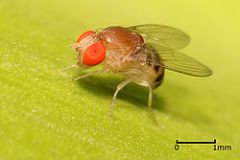
Order: Diptera
Family: ?? Common name: Fruit flies |
Family: Drosophilidae
The diagnostic characters for Drosophilidae include the presence of an incomplete subcostal vein, two breaks in the costal vein, and a small anal cell in the wing |
|
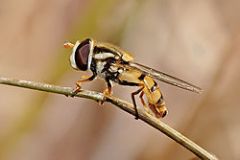
Order: Diptera
Family: ?? Common name: Hover flies |
Family: Syrphidae
As members of Diptera, all hoverflies have a single pair of wings.[2] They are brightly colored, with spots, stripes, and bands of yellow or brown covering their bodies.[2] Due to this coloring, they are often mistaken for wasps or bees; they exhibit Batesian mimicry. Despite this, hoverflies are harmless.[1] |
|

Order: Diptera
Family: ?? Common name: Horse flies, deer flies |
Family: Tabanidae
tah-BAN-ni-dee Medium- to large-sized, stout-bodied flies with wings held in single plane over abdomen. Antennae 3 segmented with 3rd segment elongate and annulated; prominent toothlike basal process present on some species. Wings with large calypters; veins R4 and R5 divergent and enclosing wing tip |
|
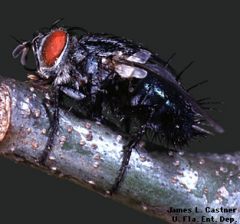
Order: Diptera
Family: ?? Common name: Tachinid flies |
Family: Tachinidae
ta-KIN-ni-dee Often resembling house flies, but are usually larger, hairier, and more robust. Postscutellum well developed, appearing as a prominent lobe beneath the scutellum |
|
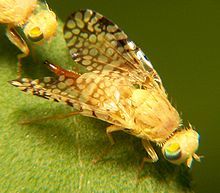
Order: Diptera
Family: ??? Common name: fruit flies |
Family: Tephritidae
To distinguish them from the Drosophilidae, the Tephritidae are sometimes called peacock flies, in reference to their elaborate and colorful markings. |
|
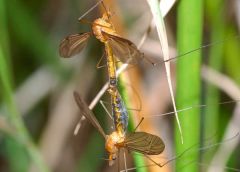
Order: Diptera
family: ?? Common name: Crane Flies |
Family: Tipulidae
Flies in this family look like giant mosquitoes (mosquitoes will not be that large). They are long-legged and long-winged with slender body. However, not like mosquitoes, they do not feed on blood. Crane flies only drink water but do not feed at adult stage. |
|
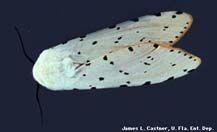
Order: Lepidoptera
Family: ?? Common name: tiger moth |
Family: Arctiidae
arc-TIE-i-dee Small- to medium-sized moths; wings held rooflike while at rest (Arctiinae, Lithosiinae) or horizontal over the abdomen (Ctenuchinae). Tiger moths often lightly or brightly colored with stripes, bands, or spots on the wings. Footman moths usually small, slender, and often dull colored. Wasp moths are slender bodied, blackish to dark-brown moths that often have a brightly colored head |
|

Order: Lepidoptera
Family: ?? Common name: Monarchs, milkweeds |
Family: Danaidae
dah-NAY-i-dee Large orange-colored butterflies with black veins and white-spotted black outer margins. Front legs reduced, as in the Nymphalidae and Satyridae. |
|
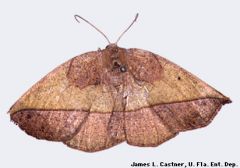
Order: Lepidoptera
Family:?? Common name: geometers, inchworms |
Family: Geometridae
gee-oh-MET-tri-dee Slender-bodied moths of small to medium size. Front and hind wings with similar pattern and coloration; moths rest on similar looking substrate with wings outstretched. Antennae variable, sometimes feathery. |
|
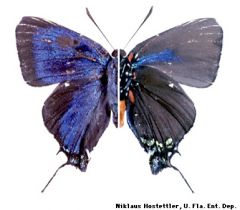
Order: Lepidoptera
Family: ?? Common name: Coppers, blues |
Family: Lycaenidae
lye-SEEN-ni-dee Usually small and delicate. Often bluish in color. The hairstreaks have delicate "tails" on the hind wings. |
|
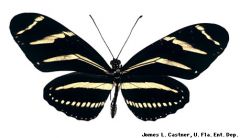
Common name: Lepidoptera
Family: ?? Common name: brush footed butterflies |
Family: Nymphalidae
nym-PHAL-li-dee Front legs reduced, but otherwise lacking characters of Danaidae or Satyridae. |
|
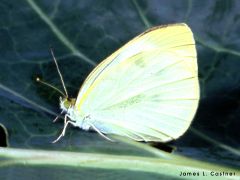
Order: Lepidoptera
Family: ?? common name: Sulfurs, cabbage whites |
Family: Pieridae
pee-AIR-ri-dee |
|

Order: Lepidoptera
Family: ?? Common name: swallowtails |
Family: Papilionidae
pah-pill-li-ON-ni-dee Most species have a taillike projection from the hind wing |
|
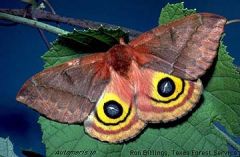
Order: Lepidoptera
Family: ?? Common name: giant silkworms |
Family: Saturniidae
sat-tur-nEYE-i-dee Large moths, often with feathery antennae. Often with transparent "eyespots" on wings. |
|
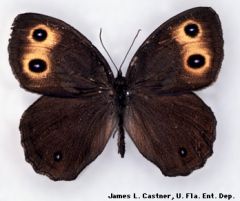
Order: Lepidoptera
Family: ?? Common name: Nymphs, Satyrs, Artics |
Family: Satyridae
sah-TIER-ri-dee Front legs reduced. Usually grayish or brownish, often with eyespots on wings. Subcostal vein swollen near base of front wing; no other family has this characteristic! |
|
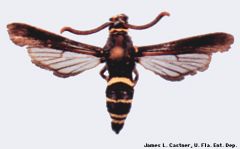
Order: Lepidoptera
Family: ?? Common name: Clear winged moths |
Family: Sesiidae
seh-SIGH-i-dee Moths often resemble wasps and bees in coloration and marking. Wings elongate, often transparent owing to the lack of scales. |
|
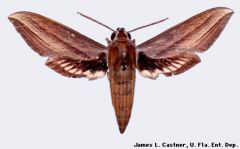
Order: Lepidoptera
Family: ?? Common name: Sphinx moths, hawkmoths |
Family: Sphingidae
sFIN-gi-dee Apex of front wing acute; hind wing much smaller than front. Antennae sometimes thickened; frequently curved or hooked at the tips, but never knobbed like butterflies and skippers |
|

Order: Lepidoptera
Family: ?? Common name: Ermine moths |
Family: Yponomeutidae
|
|
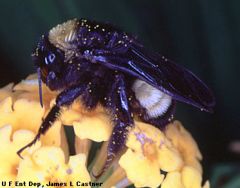
order:Hymenoptera
Family: ?? Common name: Bees |
Family: Apidae
AY-pi-dee |
|
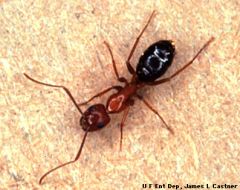
Order: Hymenoptera
Family: ??? Common name: Ants |
Family: Formicidae
|
|
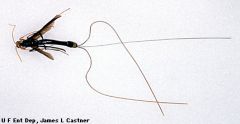
Order: Hymenoptera
Family: ?? Common name: Ichneumonid wasps |
Family: Ichneumonidae
ick-new-mon-NOID-dee-ah, ick-new-MON-ni-dee Antennae apparently with 16 or more segments. Hind trochanters 2-segmented. Two recurrent veins. Usually larger than braconids; quite variable in color. Females often with long ovipositors. |
|
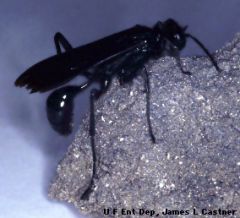
Order: Hymenoptera
Family: ?? common name: Thread waisted wasp |
Family: Sphecidae
SPHES-si-dee Sphecid wasps are distinguished from vespids and pompilids by having the pronotum short and collarlike; small rounded lobes extend towards, but do not reach, the tegulae. Sphecids are distinguished from bees by have simple rather than branched body hairs and by the lack of a flattened hind tarsus |
|
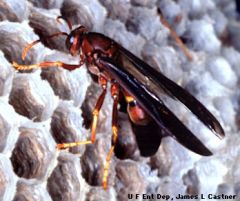
Order: Hymenoptera
Family: Common name: Vespids, yellow jackets |
Family: Vespidae
VESS-pi-dee Legs of normal length, not as long as those of the Pompilidae. Wings folded longitudinally at rest; first discoidal cell of FW greater than half the wing length (longer than pompilids). Inner margin of eye usually notched. Pronotum extending back to the tegulae, the pronotum thus appearing triangular when viewed from the side and horseshoe-shaped when viewed from above. |

